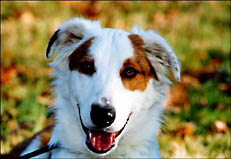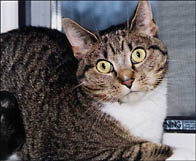|
|
|
You are here: Technique
> Capturing the Best Expression
Capturing the Best Expression
Once the animal is ready to be photographed, it is your job to try to
get the best expression you can from your subject. After photographing
hundreds of animals, I am still amazed at the wide range of emotions that
animals can demonstrate through their expression.
 It
seems that an animal's face can sometimes can be more expressive than
a human's. Animals can have their mouth closed, opened wide, or opened
a little bit, can squint or enlarge their eyes, can position their ears
it what seems like infinite combinations (especially when they move each
ear separately which is just amazing), and can move their head in a full
range of motion. It
seems that an animal's face can sometimes can be more expressive than
a human's. Animals can have their mouth closed, opened wide, or opened
a little bit, can squint or enlarge their eyes, can position their ears
it what seems like infinite combinations (especially when they move each
ear separately which is just amazing), and can move their head in a full
range of motion.
Some combinations of the positions of these eye, ear, mouth, and head
elements make for a much more desirable image than others. To make things
really interesting for you, an animal can change any one or all of these
elements from second to second! And, you really don't have much direct
control over any one of these elements. You can't instruct an animal to
put their ears up, or tilt their head. Instead, you must learn how to
work with and try to invoke the emotions of the animal to get the best
expression. This is an important distinction because if you are only accustomed
to photographing human adults, you can pretty much tell them what you
are looking for, a technique that obviously has no effect on animals and
would be frustrating to even try. When you are photographing animals,
you must rely on a bag of parlor tricks to get what you want (which oddly
enough, has a lot in common with photographing children).
What Look are You After?
 By
combing the facial elements mentioned above, animals can look happy, sad,
angry, inquisitive, sleepy, content, and just about every other emotion
there is. Some animal shelter photographs display the sad, animal behind
bars look which we do not recommend. We usually try for happy, inquisitive,
or content looks. Our favorite look from both dogs and cats is the irresistible
head tilt, ears forward, wide-eyed, inquisitive look. However, we usually
have to work hard for these kinds of expressions. By
combing the facial elements mentioned above, animals can look happy, sad,
angry, inquisitive, sleepy, content, and just about every other emotion
there is. Some animal shelter photographs display the sad, animal behind
bars look which we do not recommend. We usually try for happy, inquisitive,
or content looks. Our favorite look from both dogs and cats is the irresistible
head tilt, ears forward, wide-eyed, inquisitive look. However, we usually
have to work hard for these kinds of expressions.
Don't be Shy
Once your handler has calmed your subject, they will usually be susceptible
to facial manipulation through the use of noisemakers. I have a long lanyard
that I wear around my neck that has various whistles, bells, and bird
calls, and any other goofy noisemaker I can find on it that I use for
most animals. Noisemakers that you can use with you mouth allowing you
to keep both hands on your camera work well.
It's important not to use any of your noisemakers until the animal is
posed and you are watching them through your lens, ready to trip the shutter.
This is because after the first few times an animal hears a noise that
same noise is no longer a novelty and is therefore not effective in getting
the animal's attention any longer. Basically, the more variety you have
the better.
If the noisemakers don't work, you might to resort to yelling, waving,
snapping your fingers, or various other vaudevillian moves to get the
animal's attention. This isn't a time for you to be shy, do whatever you
have to do to get the image you want! After a while you will learn what
works well for you and it will become pretty easy for you to coax the
right expressions from your subject.
<- Back
|

